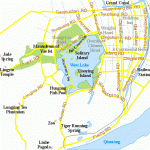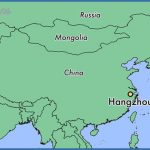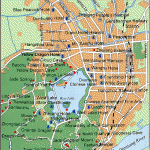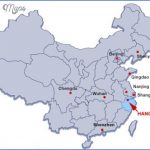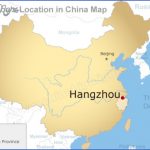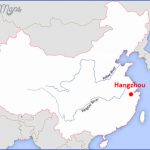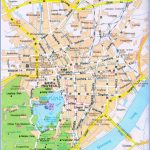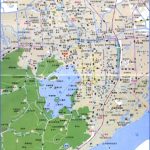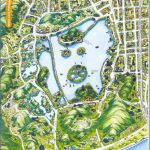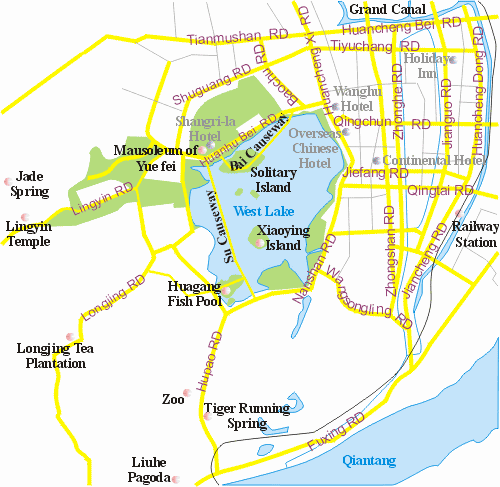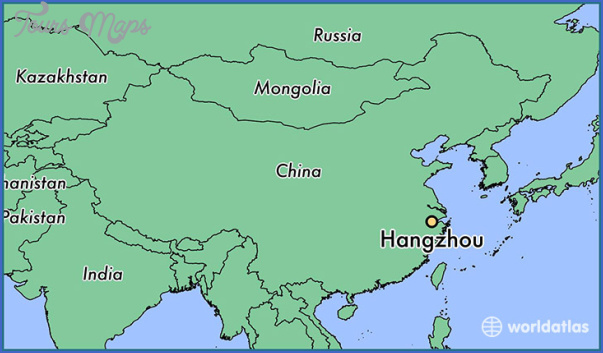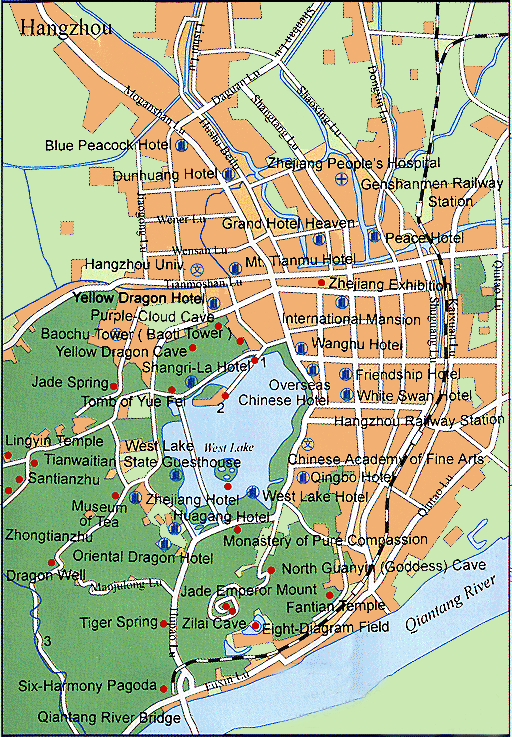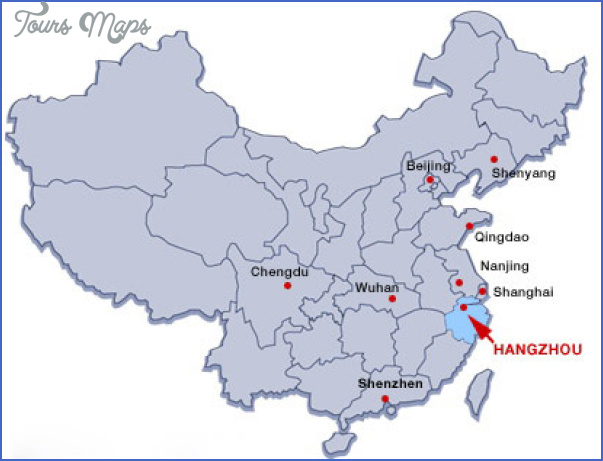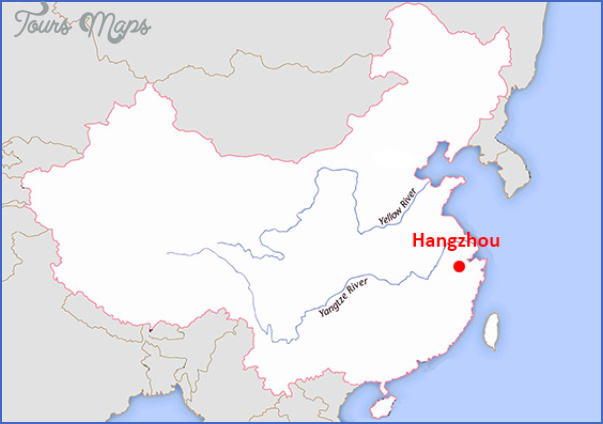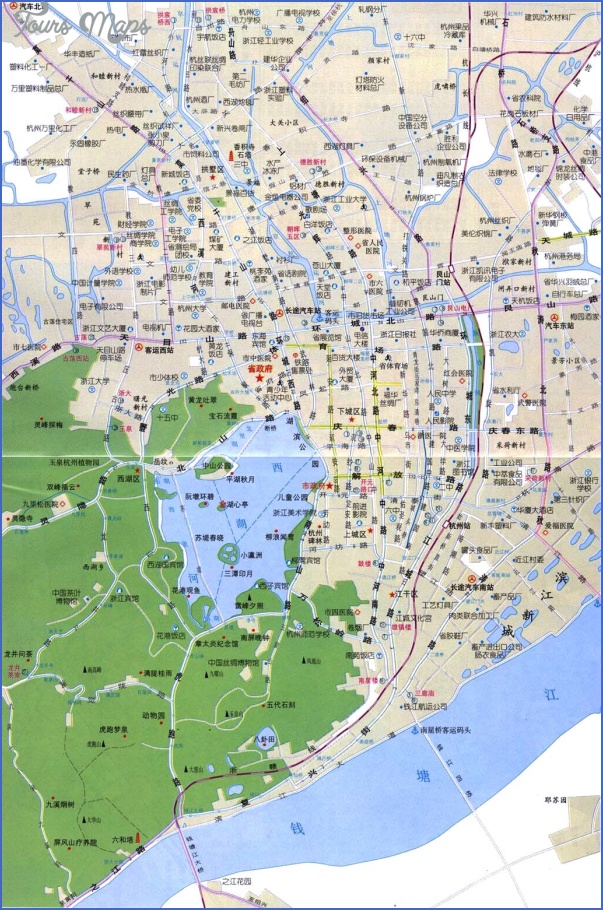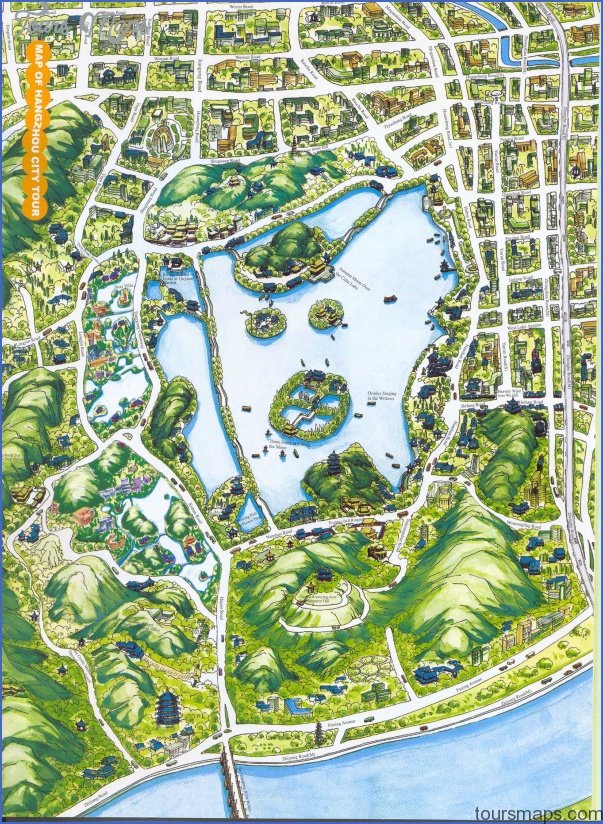Capital of Zhejiang Province
Altitude: 5m/16ft. Area: 429sq.km/166sq. miles Population: 1,220,000 (conurbation 5,440,000)
Hangzhou (Hangchow) lies in the north of Zhejiang province, in the Qian-tangjiang delta, about 40km/25 miles west of Hangzhou Bay, at 120°12’E and 30°15’N.
There are rail links with Shanghai, Nanjing, Beijing and Canton, It can also be reached by air from the major Chinese cities and from Hong Kong.
Hangzhou, popularly known as “Silk City”, is one of China’s most beautiful towns; in the words of the well-known Chinese proverb “In Heaven is Paradise, here on earth are Suzhou and Hangzhou”. The famous “Dragon Well” tea (Longjing cha) is grown in this region.
Hangzhou, one of China’s six historical capital cities, can boast of 2100 years of history. It was first mentioned as an important urban settlement known as Qiantang in 221 b.c. It was given its present name in the year 589 during the Sui dynasty (581-618); when the Grand Canal was then built between Beijing and Hangzhou the town grew rapidly in importance. From the 9th c. onwards, over a period of 237 years and under fourteen emperors, Hangzhou was repeatedly chosen to be a capital city. Its truly halcyon days began when the rulers ofthe Southern Song dynasty (1127-1279) fled here after they had lost control of north China and their capital city of Kaifeng and sought to make Handan their new capital. With them came artists and academics.
Marco Polo visited Hangzhou in the 13th c., was immediately captivated by this “Heavenly City”, as it was then known, and described it as the most beautiful in the world. Although he was impressed by the “beautiful palaces”, the “wonderfully built houses and the twelve thousand stone bridges, the streets surfaced in stone and brick and the Turkish baths, he waxed even more enthusiastic about the town’s navigational system which made it a port on both the river and the sea, and the many and varied craft workshops and their size (“every workshop employed at least ten, often fifteen, twenty, thirty or even forty men, apprentices as well as master craftsmen”).
West Lake, 5-66sq.km/2-2sq. miles in area and with an average depth of 1-5m/5ft, lies west of the Old Town of Hangzhou and is surrounded by hills on three sides. It is divided into five sections by the Sudi and Baidi Causeways; these sections are known as Outer Lake (Wai Hu), the largest of all,
North Inner Lake (Beili Hu), West Inner Lake (Xili Hu), South Lake (Xiaonan Hu) and Lake Yue (Yue Hu). There are also four islands in West Lake -Gushan, Xiaoyingzhou, Ruangongdun and Huxinting (Mid-Lake Pavilion).
Known also as “Mr Su’s Dyke (Sugongdi), this 2-8km/1% mile long causeway was built in 1089 by order of the famous poet Su Shi, who was then prefect of Hangzhou. It lies in the west part of the lake and links the north bank with the south. To build the causeway mud was dredged from the lake, dried in the sun and then reinforced by adding algae.
There are few experiences more pleasurable than an early morning stroll across the causeway in spring, past beautiful flower-beds, peach trees in blossom and weeping willows casting their shadows on the six arched stone bridges. Watching the sunrise in spring from the Sudi Causeway is one of Hangzhou’s most wonderful experiences.
In the north ofthe lake liesthis 1 km/1100yd long causeway; it is also known as “Mr Bai’s Dyke” (Baigong Di), after Bai Juyi, a famous poet from the Tang period (618-907). It begins near Broken Bridge (Duanqiao) and ends on the Isle of the Hill of Solitude (Gushan).
Broken Bridge links the Baidi Causeway with the shore. It is particularly beautiful in winter when covered with snow. A well-known Chinese love story relates how on this bridge many hundreds of years ago the White Snake, in the shape of a beautiful woman, met the academic Xu Xian for the first time. They fell passionately in love, but a malicious monk forced them to part.
This island gets its name from the 38m/125ft high hill which stands in the middle of it; from the top ofthe hill there is a fine view ofthe surrounding scenery. The following buildings are scattered over an area of 20ha/50 acres – Sun-Yat-sen Park (Zhongshan Gongyuan), the provincial museum,
Typical Chinese pavilion on Lake West the provincial library, and the headquarters of the Xiling Masonry Company (Xiling Yinshe), founded in 1903.
Built in 1699, the Pavilion ofthe Autumn Moon on the Calm Lake stands at the end of the Baidi Causeway, at the eastern end of Gushan Isle. Anyone staying in this region in autumn would do well to spend an evening here watching the moonlight spread its mystery and magic over the whole lake.
The Pavilion was built for the Qianlong Emperor Pinghu (reigned 1735 96), who also used to enjoy the moonlit view over the lake from here in autumn; an inscibed column bears his description of these magical moments, and this is why this spot bears his name.
In the north of the island is the Pavilion of the Cranes, built in the Yuan period (1279-1368) in honour of the poet Lin Hejing (967-1028). Disenchanted with corrupt officialdom he retired here to lead a quiet life. His grave is situated near the pavilion.
A small alabaster building owned by the Xiling Masonry Company houses the oldest stone tablet in Zhejiang province, the Sanlao Stele (Sanlao Bei) dating from the Eastern Han period (25-220) and discovered in 1852.
Acres in area, this island was made in 1607 from mud dredged from the lake. It contains four “mini-lakes”, linked by a zig-zag bridge, the Bridge ofthe Nine Arches (1727), and with lotus blossom and waterlilies floating on their surface. The pavilions, terraces and plants combine to produce the magic atmosphere of West Lake.
These three round stone pagodas, each little more than 2m/6%ft high and known as The Three Pools Mirroring the Moon, rise up out ofthe lake near the south bank of The Island in the Little Ocean.
They were erected in 1621 on the spot where the prefect Su Shi had built three older pagodas which were soon destroyed. The original intention was that the buildings would serve to prevent the local people from growing aquatic plants there and thus avoid mud collecting around them.
Today the pagodas serve quite a different purpose – they entertain tourists with subtle illuminated displays. In the twilight of the evening a burning candle is placed behind one of the five round windows which is covered with tissue paper. When the moonlight falls on the pagodas charming lighting effects are then mirrored on the surface of the water. Bay of Flowers The Bay of Flowers, or Huagang Park, on the south bank of West Lake, (Huagang) covers 20ha/50 acres and is filled with flower beds, containing mainly paeonies, and lawns. This was a popular excursion spot back in the times of the Song dynasty (1127-1279), and thousands of multi-coloured fish can be seen at play in a small lake which was laid out at that time. Park of the Song The Park of the Song of the Nightingale of the Willow Branch (Liulang ofthe Nightingale Wenying Gonyuan) is 17ha/42’/2 acres in size and covered with willow and ofthe Willow cherry trees. Under the Southern Song dynasty (1127-1279) it was the Branch Imperial Garden. In the middle stands a monument commemorating the peace treaty signed between Japan and China. Other Sights Hangzhou is one ofthe best towns for shopping anywhere in China. Silk is the chief local product. Other good buys include brocade, tea (“Dragon Shopping Centre Well” brand) and scissors made by Zhang Xiaoquan. These can be bought (ShangyeQu) especially in shops along Zhongshan Zhonglu, Jiefang Lu, Hubin Lu and Yan’an Lu, the streets which form the town’s main shopping quarter. Market The market, held each evening, is an experience in itself. Everything imaginable is on sale and a vast range of culinary delights can be savoured. Craftsmen of all kinds also ply their trades.
This pagoda was built in 1933 on the north bank of West Lake, on the foundations of an older pagoda built in the second half ofthe 10th c. for a high-ranking state official who sought the protection of Buddha for Qiang Hong Chu, ruler ofthe Wu kingdom. This led to the pagoda being given the name “Baochu”, which means “Protector of Chu”. It stands 45m/148ft high and is one of the town’s landmarks.
Yellow Dragon cave lies some 500m/550yd west of Baochu Ta Pagoda, at the foot of Qixia Ling hill. In the first half of the 13th c. a monk lived here; he built a hut in front of the cave, and towards the end of the Qing dynasty (1644-1911) this was extended into a Taoist monastery.
Note the spring gushing forth from the jaws of a dragon. There is a bamboo grove near the cave.
Thistemple (open: 9am-6pm) atthe northern end ofthe Sudi Causeway on West Lake was built in 1221 in honour of General Yue Fei (1103-42). Although the General had successfully repelled several Tartar raids the emperor and chancellor accused him of high treason and sentenced him to death. He was hanged together with his son Yue Yun. After his rehabilitation in 1163 two tombs were built to the west of where the temple now stands, and the bodies were reinterred there. A statue ofthe General stands in the temple hall, the ceiling of which is decorated with cranes, a symbol of immortality. Thetemple also contains 86 stone plaques on which the Song Emperor Gaozong (1107-87) and his wife engraved classical texts by Confucius. The most valuable treasure, however, is a stone celestial globe showing many of the constellations, which dates from the time of the Five Dynasties (907-960) but was not rediscovered until 1956. It is thought to be the oldest stellar map in the world. The road leading to the tombs to the west of the temple is lined with stone figures of important officials, tigers, sheep and horses. In front of the tombs are wrought-iron statues of the persons who were responsible for passing judgement on the General, the chancellor, his wife and two high officials; these are all kow-towing. In the two corridors visitors can admire 125 stelae engraved with poems by the General and inscriptions by many famous personages praising his achievements.
To the west of the Temple of General Yue Fei lie the Botanical Gardens, covering an area of more than 200ha/500 acres and boasting some 4000 different species of plants. The herb gardens and the large number of different kinds of bamboo are particularly worthy of attention. Water from the Jade Spring flows into a fish-pond.
The Jade Spring gushes forth 2km/11/4 miles west ofthe Temple of General Yue Fei, in a garden which was laid out in 1964 on the site of an old 5th c. monastery. The inscription on the wooden plaque which hangs above the ledge of the building surrounding the spring is by the well-known artist Dong Qichang (1555-1636). The Chinese characters “Yu Le Guo” mean “Kingdom of the Happy Fishes”. Various kinds of fish still swim in the waters ofthe spring.
The Temple of the Hidden Immortals, 3km/2 miles south-west of Jade Spring, dates from 326 b.c. and is one of the most famous temples in China. It is thought that in the 10th c. there were some 300 buildings here housing 3000 monks. After having been destroyed during the Taiping Uprising (1851-64) the building was rebuilt.
In the Hall ofthe Celestial Kings sits a sculpture of Maitreya and a wooden statue of Weituo from the Southern Song period (1127-1279). To the side can be seen the statues of the Four Celestial Kings.
The Sumptuous Hall ofthe Great Hero stands 33-6m/110ft high. Pilgrims come to pay homage to a gilded statue of Shakyamuni, 19-6m/64fttall and made of 24 pieces of camphor-wood. Behind the statue can be seen afigure of Guanyin.
A little to the south towers The Peak That Flew from Afar, separated from The Temple of the Hidden Immortals by a mountain stream. According to legend an Indian monk who came here in the year 326 asked “In which year did this Indian mountain fly here? When Buddha was alive it was the favourite resting place of immortal souls.” It was thus that the mountain and the monastery built in that same year both got their names.
The mountain is 168m/223ft high and riddled with numerous caves and niches, the latter containing about 380 Buddha statues which date back to the 10th c., the time of the Five Dynasties. The three oldest examples, dating from 951, can be seen on the east wall ofthe Qinglin Cave; one is of Shakyamuni, one of Avalokiteshvara and the third is a Bhaisajya (or “Medicine Buddha”) statue.
The largest sculpture on this peak is to be found on its northern slope; it is a Maitreya from the Song period (960-1279), wearing a satisfied smile and holding a rosary in one hand.
To the north of the Temple of the Hidden Immortals is North Peak (Beigao Feng), with steps leading up to it. From the top there is a superb view of West Lake and the surrounding scenery.
3km/2 miles south-west of West Lake, to the east of the village of the same name, lies Dragon Well in the midst of some beautiful countryside, a feature ofwhich arethetea plantations which produce thefine Dragon Well tea (Longjiang Cha). According to the villagers the spring which provides water for the well was discovered some time before 1800.
A visit is recommended to one of the tea factories in which the fresh tea-leaves are refined, processed and packed.
Pagoda of the Six Harmonies
The Spring ofthe Running Tiger, 5km/3 miles south of West Lake, is one of three best known springs in China. A legend describes how it was discovered in 819 with the help of two tigers. The spring produces 0-37cu.m/ 80 gallons of water per second; the quality is regarded as being extremely good and it is ideal for making tea. The high surface tension ofthe water is an interesting factor; visitors can test this by placing a coin on the surface and watching it float. There is a tea-house in the former temple nearby.
About 8km/5 miles south of the town, on the north bank of the Qiantangjiang river, the visitor will find the 60m/200ft high Pagoda ofthe Six Harmonies. When it was rebuilt in 1899 the original brick core was retained and wood-cladding added to the exterior.
On this site there once stood a former pagoda towering to a height of 150m/500ft or so, built in 970 but burned down by a foreign army in 1121. The pagoda is thought to offer protection from floods and also serves as a lighthouse.
Although from the outside the octagonal building appears to have thirteen storeys, in fact there are only seven. A staircase incorporated in the wood-cladding enables visitors to climb almost to the top. From there the view includes the 1322m/1450yd long road and rail bridge over the Qian-tangjian river which was built between 1934 and 1937 to designs by the architect Mao Yisheng.
Collected together in a park at the Pagoda ofthe Six Harmonies are 80 or so reconstructions of pagodas from all over China.
Mount Moganshan, 719m/2360ft high, lies 50km/31 miles north-west of Hangzhou and 200km/124 miles south-west of Shanghai. There are bus services from both those cities.
The word “Mogan” is formed from two separate names. Mo Xie and Gan Jiang, being those of a married couple who lived in the 5th c. b.c. Both were very skilled swordsmiths who devoted their lives to making two incomparably beautiful swords for the emperor.
Of the many picturesque spots which the countryside around Hangzhou has to offer, special mention should be made of Sword Lake, on the banks of which-so legend has it-Mo Xie and Gan Jiang would sit and polish the swords they had just forged. An impressive three-stage water-fall, 100m/330ft high, feeds water into the lake.
Hangzhou Map Photo Gallery
Maybe You Like Them Too
- The Best Cities To Visit in The World
- World’s 10 Best Places To Visit
- Coolest Countries in the World to Visit
- Travel to Santorini, Greece
- Map of Barbados – Holiday in Barbados

